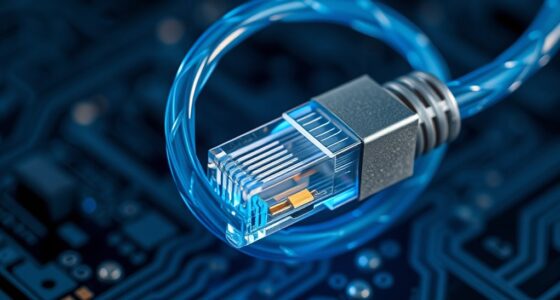Did you know that the physical infrastructure of your network can significantly impact GDPR compliance? Secure cabling isn’t just about performance; it’s about protecting sensitive data from interception, tampering, and unauthorized access. As privacy regulations tighten, understanding how your cabling setup influences data security becomes vital. But what specific measures can you implement to guarantee your physical environment supports your privacy commitments? Exploring this connection can help you reinforce your organization’s data protection strategies.
Key Takeaways
- Proper physical cabling security minimizes risks of unauthorized data access, supporting GDPR compliance.
- Encrypted data transmission over cables ensures confidentiality and reduces GDPR-related data breach risks.
- Securing cabling infrastructure helps prevent interception and tampering, aligning with GDPR’s data protection principles.
- Maintaining high-quality cabling supports reliable data transfer, essential for meeting GDPR’s privacy and integrity standards.
- Physical security controls for cabling are critical to safeguarding personal data and avoiding GDPR non-compliance penalties.

In today’s digital age, protecting data privacy starts with how you manage your cabling infrastructure. Your physical network lays the foundation for secure data transmission, and if it’s not properly safeguarded, sensitive information becomes vulnerable to interception or unauthorized access. To prevent this, you need to implement strong security measures that extend beyond digital controls, directly into your cabling setup. This involves not just investing in quality cables but also ensuring that your data remains protected through encryption protocols and access control measures integrated into your network design.
Encryption protocols are essential for safeguarding data as it travels across your cabling. They encode information so that, even if someone manages to tap into your cables, they won’t be able to decipher the data without the proper keys. When you deploy encryption protocols like AES (Advanced Encryption Standard) or TLS (Transport Layer Security), you add an extra layer of defense that makes intercepting meaningful data nearly impossible. This is especially critical if your cabling runs through public or shared spaces where unauthorized individuals might try to eavesdrop. By encrypting data at the source and decrypting it only at the destination, you ensure that intercepted signals are rendered useless, maintaining compliance with regulations like GDPR that emphasize data confidentiality. Additionally, considering the importance of high refresh rates in certain applications, ensuring that your cabling supports consistent and reliable data transmission is crucial for maintaining optimal performance.
Frequently Asked Questions
How Does GDPR Impact Data Retention Policies for Cabling Infrastructure?
GDPR requires you to implement strict data retention policies, guaranteeing you only keep data as long as necessary. For cabling infrastructure, this means you must secure data with cabling encryption and control data access tightly. Regularly review and delete unnecessary data, and ensure your cabling and network systems support these privacy measures. This keeps your organization compliant and protects sensitive information from unauthorized access.
What Are Best Practices for Securing Cabling Data Against Cyber Threats?
Imagine your cabling as a guarded fortress. To keep cyber threats at bay, you should implement strong access controls, like key gates, restricting entry to authorized personnel. Use wireless encryption to secure data transmissions, ensuring information stays locked tight inside the fortress. Regularly update security protocols, monitor network traffic, and train staff on best practices. This layered approach helps protect your cabling data from evolving cyber threats effectively.
Are There Specific Certifications for Gdpr-Compliant Cabling Systems?
You should look for certification standards like ISO/IEC 27001 and ISO/IEC 27701, which help verify cabling systems meet compliance requirements for data privacy. While there aren’t specific certifications solely for GDPR compliance, these standards demonstrate your commitment to security and privacy best practices. Guaranteeing your cabling infrastructure adheres to recognized certification standards helps you stay compliant and reduces risks related to data breaches and privacy violations.
How Often Should Cabling Security Assessments Be Conducted Under GDPR?
You should conduct a cabling security review at least once a year, or whenever significant changes occur. Think of it as keeping your finger on the pulse. Regular cabling audits help identify vulnerabilities and guarantee compliance with GDPR. Staying proactive prevents issues down the line, so schedule these assessments regularly and after any infrastructure updates. This way, you maintain data protection and keep your system secure.
What Are the Legal Consequences of Non-Compliance Related to Cabling Data Privacy?
If you don’t comply with cabling data privacy regulations, you face serious legal penalties and increased risk of compliance breaches. Authorities can impose hefty fines, damage your reputation, and demand costly corrective actions. Non-compliance also exposes you to lawsuits and contractual penalties, which can severely impact your business operations. Staying compliant helps you avoid these consequences, protect sensitive data, and maintain trust with clients and stakeholders.
Conclusion
In the end, securing your cabling isn’t just a modern necessity—it’s like guarding the crown jewels of your data kingdom. By implementing proper physical security measures and encryption, you protect sensitive information from prying eyes and cyber villains alike. Remember, even in the age of smartphones and cloud castles, a well-laid, secure cable route is your best armor in safeguarding privacy and ensuring GDPR compliance. Stay vigilant, and don’t let your data be the next victim of the black plague!









